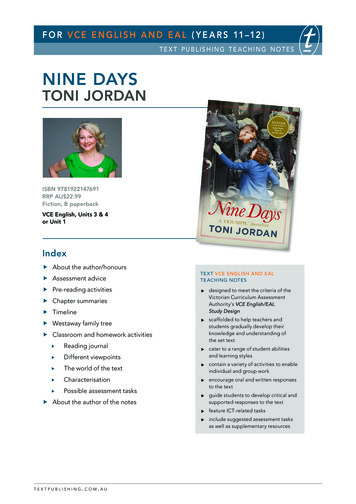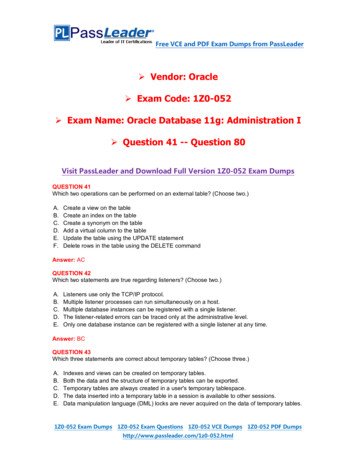
Transcription
F O R V C E E N G L I S H A N D E A L ( Y E A R S 11 –12 )te x t publishing te aching note sNINE DAYSTONI JORDANISBN 9781922147691RRP AU 22.99Fiction, B paperbackVCE English, Units 3 & 4or Unit 1IndexffAbout the author/honoursffAssessment adviceTEXT VCE ENGLISH AND EALTEACHING NOTESffPre-reading activitiesff designed to meet the criteria of theffChapter summariesffTimelineffWestaway family treeffClassroom and homework activitiesffReading journalffDifferent viewpointsffThe world of the textffCharacterisationff Possible assessment tasksffAbout the author of the notesVictorian Curriculum AssessmentAuthority’s VCE English/EALStudy Designff scaffolded to help teachers andstudents gradually develop theirknowledge and understanding ofthe set textff cater to a range of student abilitiesand learning stylesff contain a variety of activities to enableindividual and group workff encourage oral and written responsesto the textff guide students to develop critical andsupported responses to the textff feature ICT-related tasksff include suggested assessment tasksas well as supplementary resourcestextpublishing.com.au
N I N E D AY STONI JORDANT E X T P U B L I S H I N G T E ACH I N G N OT E SABOUT THE AUTHORASSESSMENT ADVICEToni Jordan is the author of four novels. Theinternational bestseller Addition (2008), was a Richardand Judy Bookclub pick and was longlisted for theMiles Franklin award. Fall Girl (2010) was publishedinternationally and has been optioned for filmdevelopment, and Nine Days was awarded Best Fictionat the 2012 Indie Awards, was shortlisted for the ABIABest General Fiction award and was named in KirkusReview’s Top 10 Historical Novels of 2013. Her latestnovel is Our Tiny, Useless Hearts (2016). Toni has beenwidely published in newspapers and magazines.Nine Days could be used to assess the followingoutcomes:From anff Outcome 1b: Produce a creative response to NineUnit 3 English/EAL and end-of-year examinationArea of Study 1Reading and creating texts:ff Outcome 1a: Produce an analytical response toNine Days (oral/multimodal or written)ORDays (oral/multimodal or written)HONOURSUnit 1 English/EALWinner, Independent Booksellers of Australia Award forBest Fiction, 2013Area of Study 1Shortlisted, Australian Book Industry Awards, GeneralFiction Book of the Year, 2013Shortlisted, Colin Roderick Award, 2013‘Simply a joy to read.’Courier-Mail‘Toni Jordan has written a beautiful novel whichcaptures the loves and fears of an ordinary Australianfamily through hard times and better times. It remindedme of Elizabeth Stead’s books.’Australian Bookseller & Publisher‘Jordan is clear that what binds us to one another andto a meaningful life is simply valuing the life you havebeen given and the family that is yours and yours alone.Reading Nine Days, you will laugh, even cry, but youwill be in no doubt that Toni Jordan uses the modernnovel to reflect those tensions that exist for many of usbetween duty and desire.’Australian Book ReviewReading and creating texts:ff Outcome 1a: Produce an analytical response toNine Days (oral/multimodal or written).ORff Outcome 1b: Produce a creative response to NineDays (oral/multimodal or written).Please note: Schools must use different texts to assessthe analytical and creative responses and can onlyassess one task in oral or multimodal form. For furtherinformation, please consult the English/EAL StudyDesign on the Victorian Curriculum and AssessmentAuthority’s website: sh/index.aspx‘Jordan’s triumph is in the structure and scope of thisnovel set in working-class Richmond, starting andending indeed in 1939 but spreading out an ensuing 70years to solve a mystery and build a love story.’Adelaide Advertiser‘This novel is a triumph. Another signal career inAustralian fiction is well under way.’Australiantextpublishing.com.au2
N I N E D AY STONI JORDANT E X T P U B L I S H I N G T E ACH I N G N OT E SPRE-READING An interview with Toni Jordan in the Sydney ime writer Angela Savage reviews Nine Days forAustralian Women cle.cfm?cid 134&objectid 10831438(Nine Days is reviewed in the NZ Herald)FilmEoin Hahessy’s documentary film, The Making of IrishAustralia, 2016, is a worthwhile htmlReading Group NotesAccess this title's notes by going to textpublishing.com.au/nine-days and selecting 'Book club notes'.All links in this document can be accessed via the digitalversion of these notes omny.fm/shows/the-garret/toni-jordan( The Garret podcast reviews and discusses ToniJordan's Nine 794(Nine Days is featured on Books and Arts)Videohttps://www.youtube.com/watch?v jW2TjCkWqug(Booktopia Presents: Nine Days by Toni Jordan[Interview with Caroline Baum])https://www.youtube.com/watch?v s6J5Po-gMLw(Toni Jordan introduces and reads from her novel NineDays)https://www.youtube.com/watch?v bdfQGTnPGZs(Toni Jordan chats to Shearer’s Bookshop)https://www.youtube.com/watch?v xZA20FPsCFs(BWF Presents Toni Jordan)textpublishing.com.au3
N I N E D AY STONI JORDANT E X T P U B L I S H I N G T E ACH I N G N OT E SCHAPTER SUMMARIESCHAPTER ONE: KIPMonday 7th August, 1939The novel’s opening chapter, ‘Kip’ provides aninitial glimpse into the lives of the members of theWestaway family, with many later details hinted atand foreshadowed. Kip narrates unfolding events as afifteen-year-old living in 1939, allowing the authenticityof his character to transport the reader into the lanes,roads, streets and parades of the working-class innercity suburb of Richmond, Victoria, as the inevitability ofWorld War II ominously looms.It is mid-winter and Kip is working as a ‘stable boy incharge of horse excrement and shovel scrubbing’ (page9) for his next-door-neighbours, the Husting family. Kiplooks after their horse, Charlie—a job which involvesmany early-morning starts. Mr Husting is kind to Kip. Hegives Kip a ‘secret’ (page 8) shilling. This shilling plays acentral role throughout the novel, helping the reader toconnect characters and order key events.Kip has given up his scholarship at the Catholicsecondary boys’ school, St Kevin’s College, to become a‘working man’ (page 4). The reason for this is not madeclear. What is made apparent though, is that this wasnot an easy decision—Mac mocks him for ‘[crying] whenhe left school’ (page 23). There is, however, a sense thatthis decision weighs heavily on his reputation, givenhis declaration that he is ‘known as chief layabout andsquanderer of opportunities’ (page 9). In contrast, hisbrother, Francis 'Frank', is still a student at St Kevin’sand plenty of sibling rivalry exists between the two.Francis clearly has more status in the family andreceives more favourable treatment. It is obvious thatKip is very bright, evidenced by his rich and energeticimagination and the fact that he won the ‘prize forEnglish composition and art’ (page 18) at St Kevin’s.This magnifies the pity that he has had to give up hisscholarship.This chapter also tells the tale of Jack Husting, the sonof Mr and Mrs Husting, who is returning home fromsomewhere he’s been for ‘eighteen months’. Classtension definitely exists with the Hustings—Ma refers toMrs Husting as ‘her ladyship’ (page 14) and Mrs Hustinglaments the fact that her family has to ‘suffer to havethe likes of [Kip] hanging around morning and night andpay for the privilege’ (page 7). Memories of World War Ihaunt Ma. She wants her boys to be ‘safe in school, notrunning around waiting for the call-up’ (page 13).Kip’s trip to the butcher for Connie introduces AnnabelCrouch as a possible love interest for Kip, whereas hisinteractions with the local gang on the return journeyallow Kip to lay bare Catholic and Protestant rivalry andthe prejudice experienced by Irish Catholics. The gang,comprised of Mac, Cray, Jim Pike and Manson, derideKip for leaving school and callously mock his father’sdeath, as well as the financial peril the family now faces(page 24). Even though Kip is kicked and spat on, hemanages to escape the gang’s clutches by harnessingthe speed of ‘Jack Titus’, the legendary Richmondfootballer of the time.The chapter concludes with Kip’s fertile imaginationleading to the loss of the boarder, Mrs Keith, who isfar from amused when he imagines her underpants are‘American parachutists coming for Mrs Husting’ (page30) but opens the door for Connie’s emancipation whenshe realises that without a ‘boarder there’s no need for[her] to stay at home’ (page 35) and she can get a job atthe newspaper, the Argus (page 36).Kip lives with his mother, his older sister Connie andhis brother Francis. The Westaways are not an affluentfamily and this manifests itself in small, descriptivedetails. For example, Kip shares a room with his ‘Ma’and Frank, and Connie sleeps on a ‘camp bed in thelaundry’. Images like this serve to emphasise how smalltheir house is. A boarder, Mrs Keith, also lives withthe family. Kip’s father’s absence is hinted at via hisdescription of the ‘old clothes pulled out of drawers’(page 2) in the bedroom, but this absence is notexplained until later in the chapter.textpublishing.com.au4
N I N E D AY STONI JORDANT E X T P U B L I S H I N G T E ACH I N G N OT E SCHAPTER TWO: STANZITuesday 25 September 2001Chapter Two is also set in Melbourne, but time hasbeen rapidly fast-forwarded. Events are unfolding atthe dawn of the 21st century. Hawthorn and Malvernare the principal locations, while Rowena Parade stillfigures in the narrative’s landscape, albeit very subtly.Unlike the first chapter, the second chapter is narratedfrom Stanzi’s point-of-view. Stanzi is a deeply unhappy35-year-old counsellor with an office in Hawthorn.Even though the postcode of her office makes it seemlike she’s a success, the leafy well-to-do locale of herpractice does not mirror her inner realities. The truthis that Stanzi is wrestling with her own inner demons;her dissatisfaction with her job and her struggleswith her weight are a recurring motif throughout thechapter. Indeed, Stanzi’s unhappiness is mirrored inthe context of the times. Even though it’s the era ofSex and the City, it’s also the era of fears about SARS,and the terrorist attack on the World Trade Centre hasjust occurred, although isn’t referred to explicitly. LikeChapter One, the world of the text is a complex place—while Australia is physically safe, the domestic sphere ofthe characters is also troubled and unsettled.The chapter focuses principally on Stanzi’s relationshipwith her client, Violet Church, particularly in regardto her ‘daddy issues eating disorder and history ofkleptomania’ (page 37). Stanzi fears that Violet hasstolen Stanzi’s father’s shilling (page 46) from her deskduring a counselling session. Stanzi’s fears lead her toViolet’s house where she is humiliated by Violet and herfather, Len Church, the nadir being the moment Violettells Len that seeing Stanzi makes her feel ‘better [and]grateful’ (page 60) because she realises, ‘“At least I’mnot fat”’ (page 61). This proves to be a major turningpoint for Stanzi. She realises that travelling to Violet’shouse was a ‘violation of [their] relationship’ (page 70)and that she ‘can’t do this job anymore’ which echoesConnie’s turning point and possible emancipation inChapter One and establishes a major theme—breakingfree.textpublishing.com.auLike Chapter One, Jordan is careful not to give awaytoo much too early, instead choosing to give small hintshere and there to help the reader place who Stanzi isand how she is connected to the first chapter. It’s verymuch like a puzzle. Stanzi’s father is presented as aloving father and the reader is told he is ‘seventy-six’and a ‘photographer’. The reader is told that Stanzi’smother is an ‘only child brought up by her father whodied just before she was married’ (page 64) and that‘Dad was her first boyfriend and only love’. A secondkey talisman is also introduced to complement theshilling—‘Mum’s amethyst pendant’ (page 63). Stanzi’stwin sister, Charlotte is also introduced. Stanzi lives inRowena Parade with twin sister Charlotte and her twochildren, Alec and Libby (page 66).While the first chapter is more about the relationshipbetween parents and sons, this chapter is very muchabout fathers and daughters. Even though Violet has‘daddy issues’, Stanzi’s relationship with her father isstrong and affirming and later in the chapter Stanzireveals her father is Kip (page 65), establishing thatthis novel will very much be about the slow reveal. Kipthen reveals—somewhat intriguingly—that his homecontains, “Fifty years of family photos, but none ofConnie. If you had met her, you’d see. You look likeher. Beautiful” (page 66), but the reason that Stanzi hasnever met her aunt and that there are no photos of herremains a mystery.5
N I N E D AY STONI JORDANT E X T P U B L I S H I N G T E ACH I N G N OT E SCHAPTER THREE: JACKSunday 25 February 1940Chapter Three takes the reader back to Richmondbefore the beginning of World War II. The chapterfocuses primarily on Jack Husting as he strugglesto adjust to life back in inner city Richmond, havingworked for ‘eighteen’ months on a station (page 77).Just as Kip and Stanzi do in the first two chapters,Jack tells his own story and Jack’s connection to Kip’sstory is revealed incrementally, reminiscent of Stanzi’schapter. Jack has been working for his uncle amongst‘horses and sheep’ (page 71) and life in the family homeabove their furniture shop in Swan Street feels stiflingin comparison. Sleeping in his childhood bed, when hehas been so used to sleeping in a swag or bunk (page71), adds to his restlessness and frustration. Richmonditself feels like a ‘poor man’s paddock’ (page 73), the‘barrenness, the ugliness, the sad crushed spaces’ and‘[a]dvertising hoardings’ combining to evoke intenseyearnings within Jack for the ‘pure air’ (pages 73–74) ofthe country.Jack’s sense of being trapped is heightened by hisfamily dynamics. He is an only child, and this is subtlyconveyed by his description that he is the ‘only nephewof a childless station owner’ (page 85). His life so farseems to have involved a series of carefully orchestratedmoves by his mother to keep him safe from war andaway from what she considers to be the wrong type ofpeople. This has meant that Jack has lived away fromhome for so long (and for so often) that her suffocatingneed to protect him, whilst ensuring he is sociallysuccessful, has led to nothing but disconnection, Jackruefully reflecting: ‘She doesn’t know me. Not at all.’(page 72)It is just before the beginning of World War II and theera of Menzies (page 80) and Australia’s loyalty toEmpire is writ large in its obedience to the King. Fearsabout the impending war has prompted overt displaysof religious duty, inspired by the King’s requestsfor ‘prayers for the Empire, prayers that we’d defeatGermany good and quick’ (pages 72–73). Jack reportsthat ‘St Stephen’s is packed to the doors’ (page 73)but unlike his mother, he is neither fearful about hissafety and soul, nor concerned with making socialconnections. Not only does Jack feel like an outsider inhis own home, the idea of war has created a fierce socialexpectation that fit and the strong men will go to war.This pressure stems particularly from ‘old timer[s]’ (page81) who fought in Pozières (page 81). Jack is questionedabout being in ‘civvies’ [civilian clothing] and accusedof being a ‘spineless bloke’ (page 82). Yet Jack isunperturbed by this social shaming; he feels no desireto go to war having ‘seen death at close quarters’ (page80). Jack’s strength of character is underlined in the factthat he feels no pressure to conform even though hispeers are swept up in the excitement of joining up andthe promise of seeing ‘European stars’ (page 81).Chapter Three also sheds further light on the story ofthe Hustings' neighbours, the Westaways, and whenJack first glances Connie Westaway ‘[a]cross the lane, inthe tiny yard next door’ (page 74) we realise that Jack istextpublishing.com.auactually Jack Husting. Jack reveals that Kip is employedby Mr Husting as ‘day labour an act of charity’ (page74), emphasising the power imbalance between thefamilies. Later we connect this to the death of Kip’sfather, who we discover was called Tom Westaway(page 100). Jack is immediately entranced by Connie,who is ‘dancing’ (page 75) instead of sweeping andhe declares, ‘She is the loveliest thing I’ve seen in allthese weeks I’ve been away from the bush’ (page 76).However, the arrival of Mrs Westaway, presented byJack as an angry and controlling figure, puts an abrupthalt to Connie’s moment of happiness. Jack sums thisup metaphorically when he remarks, ‘The music hasfinished’ (page 76).Jack’s mother tries to play matchmaker by introducinghim to Emily Stewart whose family go to St Stephen’s(page 84) and own the hardware shop on Swan Street(page 85). She is determined to see Jack married tothe right girl and goes to great lengths to impressthe Stewarts by putting on her ‘company voice’ (page84), wearing a hat and putting on a lovely afternoontea. This scene also allows Jack to underline hismother’s intense loathing of Catholics, complicatingJack’s attraction to Connie who is from the ‘family ofCatholics.next door’ (page 85). Emily may have money,but her lack of polish is obvious when she uses phraseslike ‘runned out’ (page 87) and her interest in washingmachines is lost on Jack.Therefore, as soon as he can, Jack arrives on theWestaways' doorstep with a basket of lemons (whichhe claims have come from his backyard and are a giftfrom his mother) wearing ‘an ironed shirt and [his]good jacket’ (page 91). Jack notices Kip’s facial injuriesconfirming that Chapter Three is set in the same timeframe as Chapter One.Kip's character also receives more shading. We discoverthat there are six years between Jack and Kip. MrsWestaway’s physical appearance is more sharplydelineated too, albeit in an unflattering way (page 92).Even though this is the first time they have seen eachother since before Jack went away to school (page 74),Connie already feels connected to him, having heardhim going out at night (page 97).Unanswered questions from the first chapter are alsoaddressed. Connie is working at the Argus as anassistant to the photographers (page 97). Connie’sdreams of becoming a photographer are established,as are social prejudices about photography as acareer—Francis declares that photography isn’t‘respectable’ (page 98) nor is it acceptable to be a ‘girlphotographer’. Instead, Francis values ‘a steady job. Ata desk, in the government’ (page 99).It is also revealed that Mr Westaway was a typesetter atthe Argus and that Mr Ward, Connie’s boss, took her onbecause he worked with Mr Westaway. Mr Westaway’salcoholism is named (page 102), providing a hint as towhat led to him being hit by a tram. Mr Ward is alsopresented as a romantic suitor for Connie and a way6
N I N E D AY STONI JORDANT E X T P U B L I S H I N G T E ACH I N G N OT E Sout of poverty for the family. Mr Ward also representsa path to respectability because Connie ‘won’t be ableto work’ (page 101), thus emphasising the limitationsplaced on Connie by her gender. The importance ofConnie's marrying well to Francis’ academic pursuitsis also underlined— ‘must go to university’ (page102). The prejudice suffered by Irish Catholics is laidbare when Mrs Husting tells Jack that ‘a boarder isa respectable way for a Catholic family to improvethemselves’ (page 100) and that it’s a lucky for Conniethat her ‘colouring’s not too Irish’. This foreshadowswhat Connie will choose to jeopardise and even rejectin later chapters. The value placed on breeding isalso highlighted by Mr Husting’s suggestion that MrsWestaway is ‘common’ (page 102) and that ‘layaboutboys with no responsibilities, the Kip Westaways of theworld ought to’ (page 102) fight in the war, implyingsome people are more expendable than others.The chapter ends with Jack walking the streets ofMelbourne tormented by imagined images of Conniemarrying Mr Ward and the suggestion that he will joinup to escape news of Connie’s engagement (page 104).Jack also loses his ‘lucky shilling’ (p.105) when his fatherplucks it ‘right out of the air’. This is the shilling thatJack’s dad gives to Kip and that Stanzi fears has beenstolen by her client.CHAPTER FOUR: CHARLOTTEWednesday 1 August 1990The title of Chapter Four presents the reader withanother unfamiliar name: ‘Charlotte’; however, it doesn’ttake too long for the reader to orient themselves interms of the context and setting (and piece togetherhow she fits into the broader story) because of thesignificant ground that’s already been covered in thefirst three chapters. By this stage, the reader is familiarwith the narrative’s patterning and it’s much easier tostart putting together the bits of the narrative puzzle.This chapter presents Charlotte’s perspective on a lifechanging day—the day she decides whether or not toterminate an early pregnancy (she is ‘two weeks late’)and whether or not she should tell the child’s father.Charlotte’s story is set in 1990. This is made clear by thefrequent references to important world events such asthe fall of the Berlin Wall and Nelson Mandela’s releasefrom prison (pages 121–2). References to Charlotte’syoga classes and corporate clients, as well as her workin an organic food shop, also help paint a portrait of amore modern world for the reader.Charlotte is in her mid-twenties (page 132) and it isquickly established that she is Stanzi’s sister (page123). Charlotte is very different from her sister andthis chapter enables the reader to develop theirunderstanding of Stanzi and how her life has progressedsince the end of Chapter Two, whilst developing theirknowledge and understanding of Charlotte. Accordingto Charlotte, ‘Stanzi’s going places’ (page 127) and is‘only working as a counsellor until she saves up enoughto do her PhD.’ It’s interesting to note how Charlotte’sperceptions of her sister differ from Stanzi’s negativeview of self presented in Chapter 2. By contrast,according to Charlotte, Charlotte’s life is a trainwreck:‘I have two casual jobs, no qualification, no money.Ilive in a share house’ (page 127). The sisters are close,though, and Stanzi is the first person that Charlotteturns to when she suspects she is pregnant.Charlotte’s boyfriend, Craig, is a musician whoalso works at the organic shop. He is younger thanCharlotte and resents her lack of commitment to theirrelationship. Like Charlotte, who grew up in the middleclass suburb of Malvern, Craig grew up in Brighton,another affluent suburb of Melbourne. Craig is a massof contradictions, even though he pretends to beotherwise. His ‘school tie still hangs in his wardrobe’(page 121) and his friends drink Crown Lager at hisgigs, another indication of his comfortable middleclass background. However, even though Craig isfrom a wealthy and respectable neighbourhood, he isdetermined to reject this way of life and romanticisesnotions of class, telling Charlotte that he loathes‘people like that’ (p.120) or the ‘bourgeois’ (as he callsthem). This enables Jordan to hint at the differencesbetween generations: Charlotte’s grandmother wasdesperate to ensure her children grew up to be‘respectable’ and would escape their working-classorigins, and yet for Charlotte and Craig, the greatprize of being middle class is viewed as a pretentiousideology.textpublishing.com.au7
N I N E D AY STONI JORDANT E X T P U B L I S H I N G T E ACH I N G N OT E SCraig’s cynicism about the ‘middle class’ also extendsto children (page 121) which creates further confusion inCharlotte about what to do. She is much more hopefulabout the times, believing, ‘We are.only one decadeaway from a pristine millennium’. Her sister’s pragmaticadvice, ‘It’s a short operation. No fuss. Besides I’m tooyoung and beautiful to be an auntie’ (page 133) alsocomplicates her dilemma. Charlotte also wrestles withthe question of whether or not Craig has a right to knowand whether or not having a child would impact on hiscareer, even though Stanzi tells her, ‘Your body, yourchoice’ (page 134).Another motif is introduced to complement theshilling—her mother’s ‘amethyst pendant on a goldchain’ (page 123). Like the shilling, this motif also servesas a cohesive device but as yet its significance is onlyhinted at. Further details about its provenance areprovided on page 142. Charlotte uses this pendantto tell if she is pregnant and its prophetic powers arerevealed when she declares, ‘I’m pregnant’ (page 123).Charlotte’s chapter also adds further layers to theWestaway family story and provides more rich locationdetail about the Westaway home in Rowena Parade(page 131) where Charlotte’s uncle Frank still lives.Connie’s fate is revealed very swiftly, resolving thequestion that remained at the end of Chapter Two:Connie is not in any of the photos because she is dead.Another mystery is also resolved—Mr Westaway diedfrom falling out of a tram and it is revealed that he andConnie ‘both died within a few years of each other’(page 131) but the explanation for her death is a redherring.Charlotte’s family’s success, despite the difficultyof Kip and Frank’s childhood, is suggested via herdescriptions of Kip’s family home in Malvern—a‘sprawling Federation triple-fronter in Malvern’ (page132), a world away from working-class Richmond,therefore underlining the possibility of social mobilityover generations.Stanzi’s reaction when Charlotte insists that they visittheir mother, ‘Oh my God.Dad’ (page 129) acts asanother hook. Charlotte and Stanzi’s visit to UncleFrank’s house establishes further key information—Frank lives alone and has never married or had a family(page 137), their mother is Annabel (possibly the sameAnnabel from Chapter One) and Charlotte and Stanziare twins (page 129). Further details are provided abouthow Kip and Annabel came to live in Malvern and why itis that Frank still lives in the family home (page 140) butno conversation ensues about Charlotte’s pregnancy.The chapter closes with Charlotte using the pendant tohelp her decide if she ‘should.keep the baby’ (page142) but finishes on a cliffhanger, the reader unsurewhich way the pendant circled. We don’t know if shewill tell Craig and if she will tell her family about thepregnancy.textpublishing.com.auCHAPTER FIVE: FRANCISMonday 2 May 1938This is the first chapter with a recognisable character’sname as the chapter title, highlighting to the readerhow well they have come to know the Westaway family.This chapter allows the reader to experience Frank’sperspective as teenager just before (and then after)the funeral of his father. The events in this chapteroccur before Chapter One, so the non-linear structuremeans that the reader has to keep cross-referencing thechapter with the events of ‘Kip’ and ‘Jack’. This chapterexplores the day Frank is confronted with a series ofchoices, ultimately compelling him to make a choiceabout who he wants to be—an academic boy or a pettythief.The chapter begins with ‘thirteen [-year-old]’ (page 147)Frank pretending to be Cranston [a.k.a. The Shadow],‘an American crime-busting hero, worshipped by boysthe world over’ (page 98). Given he criticised Kip in‘Jack’ for pretending to be The Shadow, by accusinghim of being ‘a baby’, this sets up the idea that Frankis full of contradictions. The Westaway home is full ofcakes which have been dropped by from well-meaning‘friends and neighbours and people from the churchand mothers from school’ (page146). The Westawayfamily faces a series of difficult choices, some easier toresolve than others. Tom’s unexpected death meanscertain poverty for the family and unless they respondquickly and pragmatically they are destined for ‘Thoseslum shacks in Mahoney Street, what they call the Valleyof Death on account of the diphtheria’ (page 148).Frank and Kip are still trying to come to terms withthe fact of their father’s loss. Frank packs a cake in hisschoolbag to distract anyone who tries to speak to himabout his father and the image of him running his handsover the kitchen seat his father ‘sat, every single night’is very moving. The story of Mr and Mrs Westaway’smarriage is also described. It is revealed that ‘Dad’speople were of different persuasion and didn’t approveand wouldn’t even come to St Ignatius for the wedding,and that’s how come we don’t know our grandparentsand aunties and uncles from that side. All FatherDonovan asked, Ma says, was that we were broughtup Catholic and went to Catholic school and Dad gavehis word’ (page 151). This echoes, presumably, theProtestant/Catholic rivalry set up thematically in the firstchapter (and which flows on into the third) and prefacesJack and Connie’s relationship later on when people willbe prepared to ‘[give] up everything’ for love.Mrs Westaway [Ma] is going to work as a ‘housemaidin a big place at Kew’ (in her mind, a respectablejob—not a job ‘in a common factory’) (page 149) andthe family ‘is taking in boarder. Myrna Keith’s sister-inlaw, the widow’ (page 150). Ma is ‘close to forty’ (page148). Connie offers to get a job rather than go backto art school and Kip offers to drop out of school. MrsWestaway tells Connie that she can look after Mrs Keithand the boys to keep the boys from ‘roaming the streetslike urchins’. Mrs Westaway’s desperate dream thatshe and her family will live a respectable life is aidedby kindness of the religious brothers at St Kevin’s and8
N I N E D AY STONI JORDANT E X T P U B L I S H I N G T E ACH I N G N OT E Sher loc
World War II ominously looms. It is mid-winter and Kip is working as a ‘stable boy in charge of horse excrement and shovel scrubbing’ (page 9) for his next-door-neighbours, the Husting family. Kip looks after their horse, Charlie—a job










